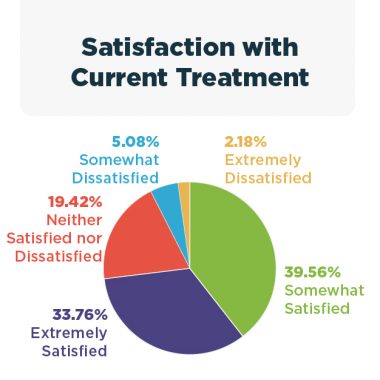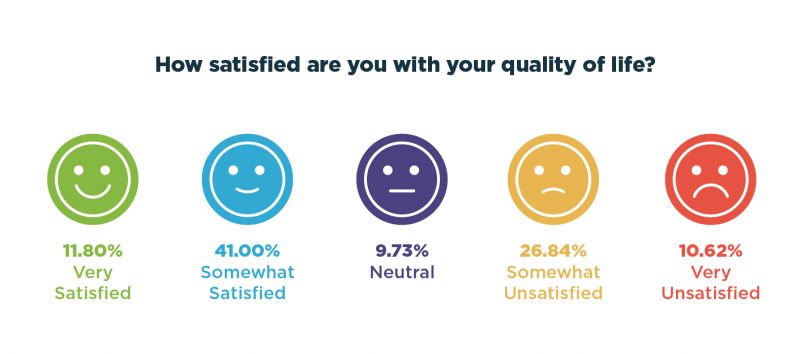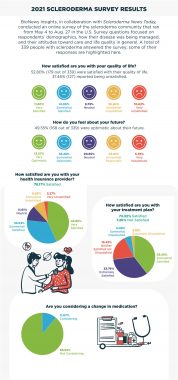Surveyed Patients Report Satisfaction With Treatment

Most scleroderma patients who responded to a U.S.-based online survey report being satisfied with their current medications and are not considering switching treatments.
However, only about half of survey respondents reported being satisfied with their overall life quality, or optimistic about the future, perhaps highlighting gaps in care for people with the disease.
The goal of this survey was to gain greater understanding of the scleroderma community and to develop data about disease management, treatment plans, medication side effects, insurance, and patient quality of life. It was conducted by Scleroderma News in collaboration with BioNews Insights, the research arm of BioNews Services, which publishes this website.
“At BioNews, we are interested in better understanding the reasons why 37.4% of patients reported dissatisfaction in their quality of life. This is an area where further research and a deeper understanding can lead to better outcomes and we are committed to pursuing that goal,” Jacob Harney, PhD, research lead at BioNews Insights, said in a statement to Scleroderma News.
Who answered the survey?
A total of 371 people responded to the survey, which ran from May 4 to Aug. 27 in the U.S. The vast majority of respondents — 339, or 91.37% — were people with scleroderma. Remaining respondents included friends, family, or caregivers of scleroderma patients.
The subsequent analysis focused only on people with scleroderma. Among these patients, the mean age was 60.67 years, and the mean time spent living with the disease was 10.47 years. Most of the patients (89.97%) identified as female, while 9.73% identified as male and one patient preferred not to disclose gender.
Based on 338 responses, most patients were white (87.87%), while 5.03% were Black/African American, 1.18% were East Asian, and 2.96% were mixed race. Other races/ethnicities each accounted for fewer than 1% of respondents.
Twenty-four patients reported having a blood relative who also has scleroderma.
More than half (52.68%) of the 336 patients who specified their type of health insurance had Medicare, while 4.76% had Medicaid, and 4.16% were insured through another government program. In addition, 39.58% had private insurance and 17.56% had another form of insurance. Just one patient reported not having health insurance.
Type of scleroderma and symptoms
Of 321 patients who specified their scleroderma type, 90.03% had systemic scleroderma, while the remaining 9.97% had localized scleroderma.
The most common subtypes of systemic disease, based on 251 responses, were diffuse systemic scleroderma (36.25%) and limited systemic scleroderma (26.29%). Additionally, 35.86% reported CREST syndrome — characterized by calcium skin deposits, Raynaud’s phenomenon, problems with the esophagus, damage on fingers’ skin and telangiectasias — typically known as limited scleroderma.
The most frequent subtypes of localized scleroderma were generalized morphea (60%) and linear scleroderma (33.33%), according to 15 responses.
As for symptoms, patients most commonly experienced Raynaud’s phenomenon (91.1%), based on 337 responses. Other common symptoms included acid reflux (79.23%), skin stiffness in the fingers, hands or arms (72.7%), thickening and swelling fingers (71.51%), and joint pain (68.84%).
Raynaud’s phenomenon was most often rated the most bothersome symptom of scleroderma (15.43%), followed by joint pain (10.98%), shortness of breath (9.79%), and limited mobility in the limbs (6.82%), based on 337 responses.
How were patients cared for?
Nearly all respondents were seeing a healthcare provider regularly. The most common types of providers were rheumatologists (91.99%) and primary care providers (56.68%), according to 337 responses.
Most (277 of 336, or 82.44%) patients were currently taking medications for scleroderma.
 The most common treatments, based on 277 patients, were CellCept (mycophenolate mofetil, 35.38%), Plaquenil (hydroxychloroquine) (22.74%), and ibuprofen (17.33%). Nearly nine in 10 patients said they were taking other medicines not related to scleroderma.
The most common treatments, based on 277 patients, were CellCept (mycophenolate mofetil, 35.38%), Plaquenil (hydroxychloroquine) (22.74%), and ibuprofen (17.33%). Nearly nine in 10 patients said they were taking other medicines not related to scleroderma.
Of the 277 patients who specified their side effects, more than half reported fatigue or a lack of energy. These also were commonly rated the most bothersome side effect, among 230 responses.
About half of the patients — 166 of 337, or 49.26% — reported having been on a scleroderma medication in the past that they had since stopped taking. The most common prior medicines included CellCept and Plaquenil. Common reasons for stopping these treatments included side effects and a lack of effectiveness.
“Lack of effectiveness and side effects are primary reasons reported for stopping medications, thus further supporting the need for investment in SCL [scleroderma] research and therapeutics,” Harney said.
Three patients reported having received an organ transplant (namely lung, spleen, or kidney) for scleroderma.
Satisfaction with life and treatment
Patients generally reported high levels of satisfaction with their medications. Among 551 responses for different medicines, recorded from a total of 277 patients, nearly three quarters — 73.32% — were satisfied, with 39.56% “somewhat satisfied” and 33.76% “extremely satisfied.”
Among the remainder, most 19.42% were neither satisfied nor dissatisfied, while less than one in 10 respondents reported dissatisfaction: 5.08% were “somewhat dissatisfied” and 2.18% “extremely dissatisfied.”
In line with high treatment satisfaction rates, most patients reported they were not considering switching medications. Common reasons for considering switching, given by 45 respondents, were concerns over efficacy and side effects such as fatigue and lack of energy.
“This is not to suggest that more effective treatments should not be pursued,” Harney said. “There are still significant needs in SCL treatment that address fatigue and lack of energy, two of the most common side effects that are also reported to be most bothersome by patients.”
 A little more than half of the 339 patients reported being satisfied with their overall quality of life: 41% were “somewhat satisfied,” while 11.8% were “extremely satisfied.” By comparison, 26.84% were “somewhat dissatisfied,” 10.62% were “extremely dissatisfied,” and 9.73% were “neither satisfied nor dissatisfied.”
A little more than half of the 339 patients reported being satisfied with their overall quality of life: 41% were “somewhat satisfied,” while 11.8% were “extremely satisfied.” By comparison, 26.84% were “somewhat dissatisfied,” 10.62% were “extremely dissatisfied,” and 9.73% were “neither satisfied nor dissatisfied.”
Likewise, roughly half of the patients were optimistic about their future, with 36.28% being “somewhat optimistic” and 13.27% “extremely optimistic.” Among the rest, 23.01% were “somewhat pessimistic,” 6.78% were “extremely pessimistic,” and 20.65% were “neutral.”
Among 336 patients, most reported being satisfied with their health insurance provider; 42.86% were “extremely satisfied” and 33.63% were “somewhat satisfied.” In addition, 11.61% were “neither satisfied nor dissatisfied,” 8.63% were “somewhat dissatisfied,” and 3.27% were “extremely dissatisfied.”
Most of the respondents said they were likely to participate in clinical trials — 28.49% were “extremely likely” and 35.01% were “somewhat likely,” based on 337 responses. Among the remainder, most (18.99%) said they were neither likely nor unlikely to participate in trials, while 8.9% selected “somewhat unlikely” and 8.61% “very unlikely.”
Also of note, more than three-quarters of patients, 77.54%, said they were interested in learning more about clinical trials, according to 334 responses.
Collectively, the survey results highlight high levels of satisfaction with care among scleroderma patients, but also indicate areas of substantial dissatisfaction where further care or support may be warranted.







